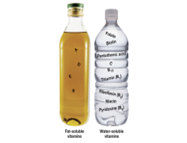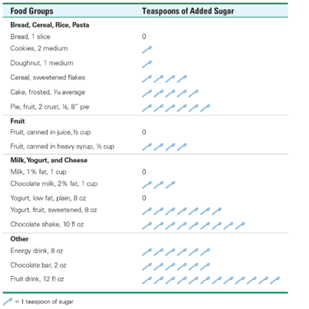Always refer to the main Pearson general guidelines and science guidance when writing alternative text for images.
When describing Health and Nutrition images, keep in mind the following key aspects and examples. Not all guidance will apply to all images.
- Be concise and don’t include unnecessary details.
- Include meaningful labels displayed in the image.
- When describing images of text, such as nutrition labels or medical forms, only transcribe the in-image text that is relevant to the purpose of the image. Unit abbreviations should be expanded to ensure a screen reader will read them correctly. For example, “10 g” should be written as “10 grams”.Abbreviations should be spelled out to ensure a screen reader will read measurements correctly. For example, 10 g should be written out as “10 grams”.
- When describing anatomical diagrams, identify the relative locations of organs based on the patient’s perspective, not the appearance of the image. For example, if a diagram shows the anterior view of the heart, the patient’s left side is on the right side of the image. So, the heart chamber in the upper right of the image is actually the left atrium.
- Use the medical terminology introduced in the textbook. For example, many health books use specific terms for different positions or views: anterior (front), posterior (back), superior (top or higher), inferior (bottom or lower), proximal (closer to the trunk), distal (farther from the trunk), etc.
- Identify the “view” for anatomical diagrams, scans, or photos. Examples: anterior, posterior, superior, inferior.
Reminder: The Mastering authoring platform has a title field and alt text field but does not have the functionality for a long description. Alternative text descriptions in Mastering may have more than 255 characters. The eText 2 authoring platform has the functionality for alt text and a long description. For more information about the different authoring systems, see Platform Authoring Information.
Examples
Example 1

Alt Text
An athlete sits on the grass beside an outdoor track. The athlete extends one leg forward and pulls back on the toe of the sneaker.
Example 2

Alt Text
Select to launch the NutriTools: Build A Meal coaching activity.
Example 3

Alt Text
Vitamins can be dissolved in fat or water. Fat soluble vitamins include vitamins A, D, E, and K. Water soluble vitamins include folate, biotin, pantothenic acid, C, B 12, thiamin B 1, riboflavin B 2, niacin, and pyridoxine B 6.
Example 4

Alt Text
A table provides the amount of sugar added to different foods groups.
Long Description
(Must be marked up in HTML)
The table provides the amount of sugar in teaspoons added to foods in different food groups, based on serving size.
| Food Groups | Food | Serving Size | Teaspoons of Added Sugar |
|---|---|---|---|
| Bread, cereal, rice, pasta. | Bread | 1 slice | 0 |
| Bread, cereal, rice, pasta. | Cookies | 2 Medium | 1 |
| Bread, cereal, rice, pasta. | Doughnut | 1 medium | 1 |
| Bread, cereal, rice, pasta. | Cereal | Sweetened flakes | 4 |
| Bread, cereal, rice, pasta. | Cake, frosted | 1 sixteenth average | 5 |
| Bread, cereal, rice, pasta. | Pie with fruit and 2 crusts | 1 eighth of an 8 inch pie | 6 |
| Fruit | Fruit canned in juice | 1 half cup | 0 |
| Fruit | Fruit canned in heavy syrup | 1 half cup | 4 |
| Milk, yogurt, and cheese | Milk, 1 percent fat | 1 cup | 0 |
| Milk, yogurt, and cheese | Chocolate milk, 2 percent fat | 1 cup | 3 |
| Milk, yogurt, and cheese | Yogurt, low fat, plain | 8 ounces | 0 |
| Milk, yogurt, and cheese | Yogurt, fruit, sweetened | 8 ounces | 7 |
| Milk, yogurt, and cheese | Chocolate shake | 10 fluid ounces | 9 |
| Other | Chocolate bar | 2 ounces | 6 |
| Other | Fruit drink | 12 fluid ounces | 12 |
Dated: 2023-12-01
